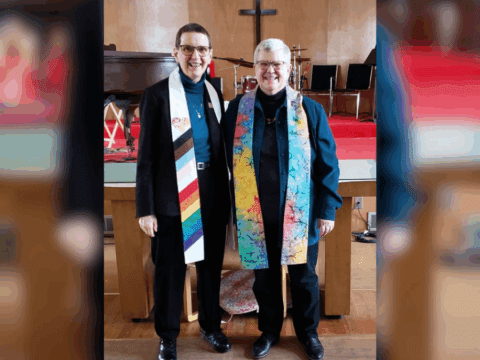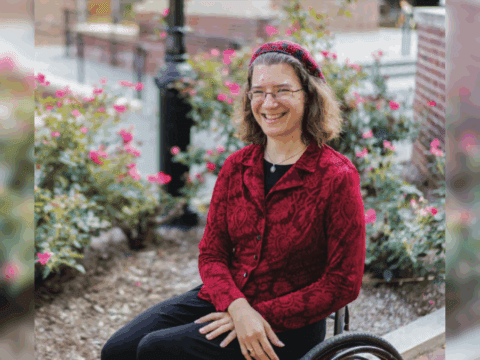This piece is the eighth in a series of reflections about Lent and Holy Week.
How to celebrate Easter in the midst of the pandemic, when I’m caught in Good Friday, not ready for Hallelujahs? I feel more like Mary Magdalene on Sunday morning, heading off to the tomb, “while it is still dark,” bringing her pain and confusion. But still, she went to the tomb. Some days I think the best we can do is simply show up, dragging our grief and our questions along with us.
Even when it gets worse—like discovering that the tomb is empty and thinking grave-robbers, not resurrection; like thinking we’re coping until the daily news explodes with ever more terrifying statistics. But maybe Easter starts with weeping outside the tomb; maybe tears open up space for comfort; as Bengali poet, Tagore, wrote: “Hope is the bird that sings to greet the dawn while it is yet dark.” Maybe….
Jesus appears to Mary, but she doesn’t recognize him—which always astounds me. But perhaps that’s how it happens—an everyday, ordinary gardener suddenly shines; it all depends on how deeply and attentively we look. Easter often comes in disguise; we need resurrection glasses to see Christ.
More Holy Week reflections from Broadview:
The Palm Sunday donkey has an important message for us
This Holy Monday, remember that Easter will still come
This Holy Tuesday, there is no doubt that we are broken
This Holy Wednesday, consider a new symbol for our faith
Maundy Thursday’s foot-washing is more than a re-enactment
On Good Friday amid a plague, a hard truth emerges
Holy Saturday is sacred time for anyone who has lost
This Jesus-gardener asks questions, “Why are you weeping? Who are you looking for?” Maybe that’s how Easter begins—with a Jesus who challenges what we think is obvious, who seeks to shift our perspective, trying to help us see differently. The questioning Christ….
Mary does recognize Jesus when he speaks her name, “Mary!” Maybe that’s the Easter moment—when we are seen and known, all the way down, and we hear our name spoken with total love; when we accept our acceptance, and, like Mary, we answer back, “Rabbouni!” Recall words from another poet, Isaiah: “Fear not, for I have redeemed you; I have called you by name, you are mine.” (Isaiah 43) Yes, crucifixion, pandemic, suffering; but also love and life, and redemption songs.
Resurrection is not just comfort. It is always about change, transformation, a new creation.
Mary reaches out to embrace her Jesus, but she’s told to maintain social distancing. “Don’t cling to me,” says Jesus. Perhaps that’s another Easter moment, when we recognize that we can’t bring back the past, can’t hold on to the way it used to be. Resurrection is not just comfort. It is always about change, transformation, a new creation: “Behold [says God], I am doing a new thing!”
Can we catch a glimpse of what our lives can be like, what the world might become? Can we trust this holy promise, where Jesus declares that resurrection has everything to do with being connected to, and empowered by, “my Father and your Father, my God and your God?” Maybe Easter becomes a verb, not a noun; a process, not a date; a becoming, not an event. As the poet Hopkins writes, “Let [Christ] easter in us, be a dayspring to the dimness of us….”
Finally, Jesus says, “Go!” Mary can’t stay in the garden; we can’t be in our church sanctuaries. But as we share good news in the world, speaking and acting with love, then surely God will easter in us.
Broadview is an award-winning progressive Christian magazine, featuring stories about spirituality, justice and ethical living. For more of our content, subscribe to the magazine today.
















But Gary, a mistranslation putting Easter where Passover should be, the World is caught in a deception. It isn’t scriptural, neither is Lent or Christmas. These are additions the Catholic hierarchy has made up…! Plus many more!
And where do we get three days and three nights out of a Friday crucifixion and Sunday resurrection?
Jesus was answering the Pharisees’ question of doing a miracle to prove His Messiahship. He said “No sign shall be given but Jonah being three days and nights in the belly of a fish, so shall the son of man be three days and three nights in the grave. 72 hours not 36.”
Remember this was to be a sign that He was their Messiah, the truth, not a lie. Easter is a lie.
Mr Burns
You are looking for a literal three days and nights – which is only found in Matthew 12:40. (All other accounts say He will rise on the third day) The point in Matthew was to refute the Pharisees looking for a sign. Obviously they understood it, because they went to Pilate claiming Jesus would rise on the “third day”. Matthew 27:61…
A day in the life of Christ (Jewish thought) was sundown to sundown or a part thereof. Friday, Saturday, Sunday. (It would be the same as: “I just spent all day on the phone trying to reach the Government office.” Did I stay on the phone for 24 hours? I doubt it.)
Why did the early Church meet on the first day of the week and call it the Lord’s day?
As I’ve stated before, it matters not about terms used to describe Christian events. (Lent, Christmas, Easter) What matters most is that those who are unsaved and do not know Christ have some exposure to the Gospel during these times.
Easter of all “Christian” holidays is the most valid, it is verified by the Passover week.